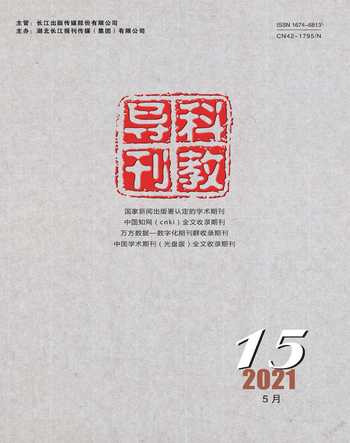培育目标的定位能力
李德强
课堂教学中,围绕教学目标展开教学活动是实施教学的根本要求,有什么样的教学目标就应该有与之相匹配的教学过程。但事实上,教学目标与教学过程的“两张皮”现象十分常见,究其原因,目标未能入脑入心是关键,再进一步追问,便是淡化了目标制定的过程性特征,而教师目标定位能力的缺失是主要问题。
目标定位就如利用卫星系统找到地球上某一观测点所在的位置一样。一节课的“位置”也需要从学生、课程、教材、学科关联等多个不同的维度或方向出发,最后汇聚在某一点上,这一点就是目标的核心所在了。这个道理谈起来似乎大家都明白,但做出来并且做好并不容易,因为目标定位是一个分析、提炼、表达的过程,是一种能力的体现。这种能力是在长期的教学实践中,不断积累、磨炼而形成的,这与教学实际中常见的照搬照抄或者简单叠加拼凑是大相径庭的。科学课程因其实践性、综合性特点,需要科学教师在目标定位能力的淬炼上下更大的功夫。
首先,要唤醒目标定位的意识。教师几乎每天都在制定教学目标,为什么还需要唤醒呢?几年前,我们就目标的塑造过程进行过调研,但遗憾的是,现在的访谈结果与之前相比并无多大改观。很多教师依然习惯于照样画葫芦,虽然有教学目标,但缺少目标的定位过程。也有的教师会从宏观到微观理论一番,但一旦落实到具体的教学目标,两者就又相去甚远了。产生这些状况的背景很复杂,但满足于唾手可得的现成目标,止步于“树木”而不愿去打开或者打不开“森林”是很现实的存在,说其目标定位意识沉睡一点也不为过。改变这一困局的重要途径就是要在教师的思维深处植入“定位”的理念,升华“定位”的教学实践意义。
其次,要认识并丰富自身的知识结构。“学科教学知识”的相关理论告诉我们,实践性知识是教师专业发展的主要知识基础,在教师的工作中發挥着不可替代的作用。目标定位过程就是实践性知识的具体体现。在科学教师目标定位能力的形成中,需要在实践中不断寻求与理论的对话,创造属于自己的学科教学新知识,而不是简单地将理论强加到实践中。这就意味着科学教师要走这样一条发展之路:在具体的目标拟定活动中,从科学知识、科学探究、科学态度、科学技术社会与环境等四个维度出发,下寻基础,上观方向,相互关联,初步形成目标之后,再在教学实施中检验目标的科学性和合理性,从理论的角度找到解释的依据,进而对目标作出进一步的调整。如此反复,长期积累,也就具备了丰富的目标定位实践性知识,能力也会随之得到提升。在这一过程中,科学教师面临的最大问题有两个:一是自主阅读。在很多人的心目中,科学教师要多锻炼动手能力,而阅读被放到不重要甚至忽略的位置,这是极大的误区。在目标定位的过程中,阅读是时时相伴的。在寻求与理论对话之前,教师要知道理论在哪里;在对话中,要厘清有哪些理论是可用的;在对话之后,要明白理论给了我什么。而这一切都与阅读紧密相关。二是在比较中改进。许多科学教师的目标定位能力多年徘徊在同一水平,为什么呢?其中一个重要原因就是对目标分析的欠缺,课上完了目标就“躺”在了备课本里,明年再接着用,这无疑使教师痛失了实现目标定位能力发展的时机。所以,前期的目标在与理论对话之后,应该产生后续的改进目标。这一比较、改进过程正是促进科学教师目标定位能力形成的重要一步。
第三,要在动态调整中锤炼。学生活动的生成性等特点就决定了目标的定位有一个动态变化的阶段。判断目标定位能力大小的一个重要标准,就是在直面学生活动时,能否依据学情及时对目标进行修正。值得注意的是,关于学情分析,大多数科学教师只关注了学生已有的认知水平和经验,而缺失了对学生课堂活动状态的即时观察与判断,而这一点正是动态调整目标,准确定位的关键。坚持在判断与调整中发挥目标的导向作用,带来的不仅是教学目标与教学过程的高度一致,还有教师目标定位能力的持续提升。
总之,目标定位能力是教学实施中的关键能力,应该得到自觉、主动地发展,这或许能成为实现教师教学水平转折的重要切入口。
Cultivating the Ability of Target Orientation
LI Deqiang
LI Deqiang
Deputy Editor in Chief of Science Textbook of People’s Education Hubei Education Press
Vice Chairman of Primary School Science Teaching Steering Committee of Hubei Provincial Department of Education
Excellent Expert in Yichang City, Hubei Province
In classroom teaching, it is the fundamental re? quirement to carry out teaching activities around the teaching objectives. What kind of teaching objectives should be matched with the teaching process. But in fact, the phenomenon of "two skins" between teach? ing objectives and teaching process is very common. The reason is that the goal cannot enter the mind and heart is the key. Further questioning is to weak? en the process characteristics of goal setting, and the lack of teachers’ goal positioning ability is the main problem.
Target positioning is the same as using satellite system to find the location of an observation point on earth. The "position" of a course also needs to be set out from many different dimensions or direc? tions such as students, courses, textbooks, discipline associations, and finally converge on a certain point, which is the core of the goal. It seems that everyone knows this truth, but it is not easy to do it and do well, because the goal orientation is an analysis, re? fining and expression process, and it is a manifesta? tion of ability. This ability is formed by accumulation andtemperinginthelong-termteachingpractice, which is quite different from the common copying or simply overlapping in teaching practice. Because of itspracticalandcomprehensivecharacteristics,sci? ence curriculum needs more efforts of science teach? ers in the training of target orientation ability.
First, we should wake up the consciousness of target orientation. Teachers are setting teaching goals almost every day. Why should we wake up? We did a survey of the goal shaping process a few years ago, but unfortunately, the results of the interview have not changed much compared with the previous ones. Many teachers are still used to drawing gourds asusual. Althoughtheyhaveteachinggoals, they lack the process of positioning goals. Some teachers will have a macro to micro theory, but once they reach the specific teaching objectives, they will be far from each other. The background of these situa? tions is complex, but it is very realistic to meet the ready-madegoalsavailable,stopat"trees"rather than open or not open up "forest". It is not too much to say that their goal orientation consciousness is sleeping. The important way to change this dilem? ma is to implant the concept of "positioning" in the deep of teachers’ thinking and sublimate the practi? cal significance of "positioning".
Secondly, we should understand and enrich our own knowledge structure“The relevant theory of "sub? ject teaching knowledge" tells us that practical knowl? edge is the main knowledge base of teachers’ profes? sional development and plays an irreplaceable role in Teachers’ work. The process of target orientation is the embodiment of practical knowledge. In the forma? tion of science teachers’ goal orientation ability, we need to constantly seek dialogue with theory in prac? tice, and create our own subject teaching new knowl? edge, rather than simply force theory into practice. This means that science teachers should take such a road of development: in the specific goal setting activ? ities, starting from the four dimensions of scientific knowledge, scientific inquiry, scientific attitude, sci? ence and technology, society and environment, they should look down on the foundation, look up on the direction, and connect with each other, and then test thescientificityandrationalityof thegoal inthe teaching implementation after the initial formation of the goal, From the theoretical point of view to find the basis for the explanation, and then make further adjustments to the goal. So repeatedly, long-term ac? cumulation, will have a wealth of practical knowledge of target positioning, ability will also be improved. In this process, there are two biggest problems for Sci? ence Teachers: one is autonomous reading. In many people’sminds,scienceteachersshouldexercise more hands-on ability, and reading is not important or even ignored, which is a great misunderstanding. In the process of target orientation, reading is always accompanied. Before seeking a dialogue with the theo? ry, teachers should know where the theory is; In the dialogue, we should clarify which theories are avail? able; After the dialogue, understand what the theory gives me. And it’s all about reading. The second is toimproveincomparison.Manyscienceteachers have been at the same level for many years. Why? One of the important reasons is the lack of goal anal? ysis. After class, the goal will be "lying" in the text? book, and will be used next year, which undoubtedly makes teachers lose the opportunity to achieve the development of goal positioning ability. Therefore, the early goal after the dialogue with the theory, should produce the follow-up improvement goal. This pro? cess of comparison and improvement is an important step to promote the formation of science teachers’ goal orientation ability.
Third, we should temper in dynamic adjustment. Thegenerativecharacteristicsofstudents’activities determine that the orientation of goals has a dynamic stage. An important criterion to judge the ability of target positioning is whether the target can be correct? ed in time according to the learning situation when facing the students’ activities. It is worth noting that most science teachers only pay attention to the stu? dents’ cognitive level and experience, but lack the re? al-time observation and judgment of students’ class? room activities, which is the key to dynamically ad? justthegoalandaccuratelyposition.Insistingon playing the guiding role of goals in judgment and ad? justment will not only bring about the high consisten? cy between teaching goals and teaching process, but also the continuous improvement of teachers’ goal po? sitioning ability.
In a word, the ability of target orientation is the key ability in the implementation of teaching, which should be developed consciously and actively, which may become an important entry point to realize the turning point of teachers’ teaching level.

